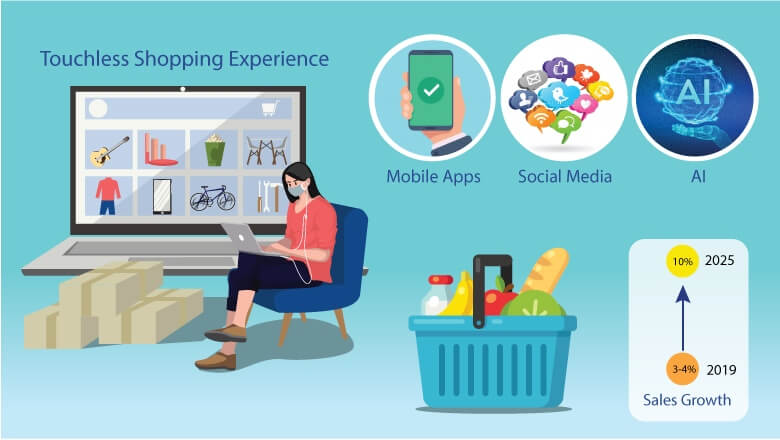The grocery business is fundamentally changing as store owners embrace new technologies and drive digital transformation. While there are many benefits of digital technologies in grocery stores, owners must be ready to think long-term, bring changes in their processes and be bold in adopting new innovations.
In the last two decades, e-commerce has transformed the way we shop and buy. Except for buying groceries wherein a large part of the population still like to go to a grocer and buy their favorite veggies, meat and cheese. But due to the COVID-19 pandemic, the grocery sector had to adapt to disruptive changes overnight as contactless became the new normal. A consumer survey by 451 Research (an offering of S&P Global Market Intelligence) found that nearly 24% of the participants had tried delivery services, both for groceries and restaurant takeout, for the first time as a result of the global pandemic. While the momentum is expected to wane as the world returns to normalcy, the grocery shopping is disrupted forever.
According to an analysis by McKinsey, the online grocery sales in the US is expected to increase from 3 –4% per cent in 2019 to more than 10% by 2025 as major retailers invest in automation and explore innovative operating models to address challenges in fulfillment and the last-mile delivery. Digital technologies like mobile apps, social media, AI, etc., are expected to help grocers embrace the change easily and make compelling offers and shopping experiences that would make consumers attracted to online grocery shopping.

4 Key Areas for Digital Transformation in Grocery Business
- Understanding the Customer: Grocers to date has access to limited consumer data generated from PoS (Point of Sale) transactions and loyalty cards. But that is set to change as grocers go online. They will have access to a range of data on customers, including orders, buying habits, browsing history and shopping frequency, etc., that can help them understand the needs of their customers better.
- Optimizing In-Store Experiences: Digital technologies for grocery stores can help grocers offer personalized shopping experiences and drive efficiency in their in-store operations. By going digital, grocers can address two of their big challenges ‘out of stock’ and ‘excess inventory’ as they are able to accurately predict demands, dynamically change prices and get real-time data on inventories. Large grocery retailers with multiple shops at various locations would be able to localize their offerings based on consumer preferences and demands.
- Streamlining Supply Chain: The grocery supply chain till a few months back was heavily compartmentalized, manual and disconnected. The digital transformation of grocery stores will fundamentally transform the supply chain, making it leaner, agile and responsive to customer demands. A digital-led supply chain process would be able to accurately predict customer demand, adjust the supply to meet it, and make data-driven decisions to supply the products to the consumers.
- Engaging the customers: One area where online stores have a massive advantage over physical stores is in the use of modern engagement tools like email-marketing, contextual ads and targeted campaigns. Therefore, the brick-and-mortar grocery shops had to rely on TV/radio/newspaper ads, billboards and leaflets which apart from being expensive are also tough to measure in impact. As grocers go digital, they would be able to use the engagement tools that are cost-effective and easily measurable.
Mobile app notifications, in-store messaging, digital coupons, and other smart marketing tools allow you to quickly roll out targeted campaigns. Chatbots or conversational bots on mobile app and websites can not only help you engage with your customers in creative ways but also help you in customer support. This allows grocers to push sales and cleanup inventories before the stocks get damaged through aggressive pricing.
Tips for Optimally Leveraging Digital Technologies in Grocery Stores
Where to begin? Here are a few tips for grocers who are starting their digital transformation journey-
- Think Digital + Physical: The grocery business is tough to run completely online. The majority of customers want to buy fresh items and be assured of the quality of the products. Your digital initiatives should be an extension of your physical stores. ‘Click to collect’ and ‘home delivery’ models can be a good place to start. Start with creating a digital store wherein customers can place orders through the website and mobile apps and get desired items home-delivered or they can pick it from the stores.
- Create Touchless Shopping Experience: COVID-19 has made contactless or touch-free shopping experience a necessity. You need to enable mobile app ordering, curbside pick-up, the contactless payments, automatic doors and touchless checkouts in your stores to makes your customers feel safe. According to the National Retail Federation, if executed properly, contactless commerce can facilitate customers conducting the entire shopping on their mobile devices without touching anything in the store.
- Leverage Robust Demand-Forecasting Tools: You would need an accurate prediction of demand to keep your supply chain efficient. One of the biggest challenges in online commerce is the urge for the ‘instant gratification’ of customers. Groceries are something that your customers would like to get delivered within 24 hours at max. The sooner the better. Accurately predicting customer demand will help you make your deliveries faster.
- Empower Your Employees with Mobile Apps: Build mobile apps for employees and provide them access to business data on their mobile devices. This will not only help you today when you are working with reduced staff size but also in the future. Information at their fingertips will help your employees, especially store associates better serve your customers. They will have real-time information on stock availability to assist customers in their shopping. Mobile apps can also be built for staff management, reporting and training your employees.
- Modify Your Business to Embed Digital: Digital transformation is not just about embracing new technologies. It is also about adapting to a new culture and work process. For example, you would be moving from a weekly/monthly reporting process to real-time data that would require quick decision-making and alignment of your processes with the technology.
This is an exciting time for the grocery business as it adapts to disruptive technologies and new business models. The shift will allow supermarkets and grocery stores to combine in-store experience with eCommerce strategy and go toe-to-toe with disruptive online retailers. Gemini Consulting & Services can be your digital transformation partner and help you accelerate your digitization initiatives. Our digital services consulting and execution services are designed to help businesses effectively leverage the power of digital technologies. To gain a competitive advantage and innovate to disrupt, contact us.



